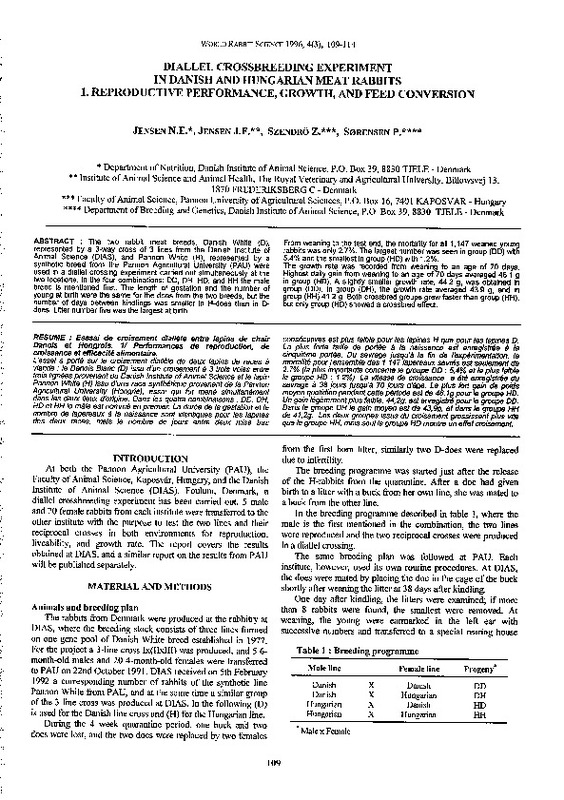JavaScript is disabled for your browser. Some features of this site may not work without it.
Buscar en RiuNet
Listar
Mi cuenta
Estadísticas
Ayuda RiuNet
Admin. UPV
DIALLEL CROSSBREEDING EXPERIMENT IN DANISH AND HUNGARIAN MEAT RABBITS 1. REPRODUCTIVE PERFORMANCE, GROWTH, AND FEED CONVERSION
Mostrar el registro sencillo del ítem
Ficheros en el ítem
| dc.contributor.author | Jensen, N.E.
|
|
| dc.contributor.author | Jensen, J.F.
|
|
| dc.contributor.author | Szendrö, Z.
|
|
| dc.contributor.author | Sorensen, P.
|
|
| dc.date.accessioned | 2011-03-21T11:00:30Z | |
| dc.date.available | 2011-03-21T11:00:30Z | |
| dc.date.issued | 1996 | |
| dc.identifier.issn | 1257-5011 | |
| dc.identifier.uri | http://hdl.handle.net/10251/10460 | |
| dc.description.abstract | [EN] The two rabbit meat breeds, Danish White (D), represented by a 3-way cross of 3 lines from the Danish lnstitute of Animal Science (DIAS), and Pannon White (H), represen_ted by a synthetic breed from the Pannon Agricultura! University (PAU) were used in a diallel crossing experiment carried out simultaneously at the two locations. In the four combinations: DD, DH, HD, and HH the male breed is mentioned first. The length of gestation and the number of young at birth were the same for the does from the two breeds, but the number of days between kindlings was smaller in H-does than in Ddoes. Litter number five was the largest at birth. From weaning to the test end, the mortality for all 1, 147 weaned young rabbits was only 2.7%. The largest number was seen in group (DD) with 5.4% and the smallest in group (HD) with 1.2%. The growth rate was recorded from weaning to an age of 70 days. Highest daily gain from weaning to an age of 70 days averaged 46.1 g in group (HD). A slightly smaller growth rate, 44.2 g, was obtained in group (DD). In group (OH), the growth rate averaged 43.9 g, and in group (HH) 41.2 g. Both crossbred groups grew faster than group (HH), but only group (HD) showed a crossbred effect. | es_ES |
| dc.description.abstract | [FR] L'essai a porté sur le croisement dial/ele de deux /apins de races a viande : le Danois Blanc (D) issu d'un croisement a 3 trois voies entre trois lignées provenant du Danish lnstitute of Animal Science et Je Japin Pannon White (H) issu d'une race synthétique provenant de la Pannon Agricultura/ University (Hongrie), essai qui fut mené simultanément dans les deux lieux d'origine. Dans les quatre combinaisons : DD, DH, HD et HH le mlJ/e est nommé en premier. La durée de la gestation et Je nombre de /apereaux a la naissance sont identiques pour les lapines des deux races, mais le nombre de jours entre deux mise bas consécutives est plus faible pour les lapines H que pour les lapines D. La plus forte taille de portée a la naissance est enregistrée a la cinquieme portée. Du sevrage jusqu'a Ja fin de l'expérimentation, la mortalité pour /'ensemble des 1 147 lapereaux sevrés est seulement de 2, 7% (la plus importante conceme le groupe DD : 5,4% et la plus faib/e le groupe HD: 1,2%). La vitesse de croissance a été enregistrée du sevrage a 38 jours jusqu'a 70 jours d'IJge. Le plus fort gain de poids moyen quotidien pendant cette période est de 46, 1g pour Je groupe HD. Un gain légérement plus faible, 44,2g, est enregistré pour le groupe DD. Dans Je groupe DH le gain moyen est de 43,9g, et dans le groupe HH de 41,2g. Les deux groupes issus du croisement grossissent plus vite que le groupe HH, mais seul Je groupe HD montre un effet croisement. | |
| dc.description.sponsorship | The experiment was partly financed by the EU-project for co-operation in Science and Technology with Central and Eastern European Countries, project no. ERB 3511 PL 922921. | |
| dc.language | Inglés | es_ES |
| dc.publisher | World Rabbit Science. ICTA. UPV | es_ES |
| dc.relation.ispartof | World Rabbit Science | |
| dc.rights | Reserva de todos los derechos | es_ES |
| dc.title | DIALLEL CROSSBREEDING EXPERIMENT IN DANISH AND HUNGARIAN MEAT RABBITS 1. REPRODUCTIVE PERFORMANCE, GROWTH, AND FEED CONVERSION | es_ES |
| dc.type | Artículo | es_ES |
| dc.date.updated | 2011-03-21T10:32:40Z | |
| dc.identifier.doi | 10.4995/wrs.1996.280 | es_ES |
| dc.relation.projectID | info:eu-repo/grantAgreement/EC//ERB 3511 PL 922921/EU/ | es_ES |
| dc.rights.accessRights | Abierto | es_ES |
| dc.description.bibliographicCitation | Jensen, N.; Jensen, J.; Szendrö, Z.; Sorensen, P. (1996). DIALLEL CROSSBREEDING EXPERIMENT IN DANISH AND HUNGARIAN MEAT RABBITS 1. REPRODUCTIVE PERFORMANCE, GROWTH, AND FEED CONVERSION. World Rabbit Science. 04(3). https://doi.org/10.4995/wrs.1996.280 | es_ES |
| dc.description.accrualMethod | SWORD | es_ES |
| dc.relation.publisherversion | https://doi.org/10.4995/wrs.1996.280 | es_ES |
| dc.description.volume | 04 | |
| dc.description.issue | 3 | |
| dc.identifier.eissn | 1989-8886 | es_ES |
| dc.contributor.funder | European Commission |








